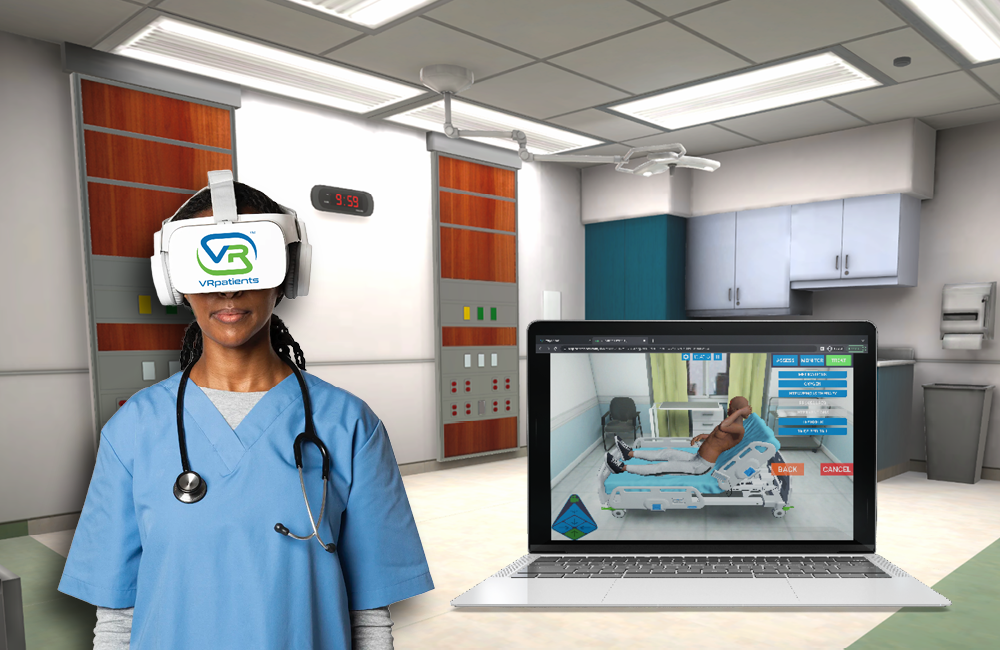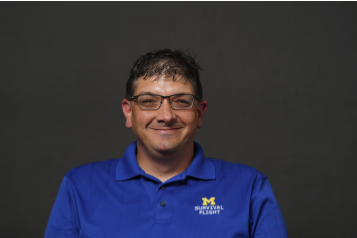
Giving students the ability to make mistakes and learn from those mistakes is an important part of learning to be a nurse or emergency responder.
Emerging technologies like virtual reality can help.
The tagline for VRpatients is Real life training without real life consequences.
Instructors can use VR technology to create scenarios involving whatever they want a student to focus on.

“With tools like VRpatients, I can direct students to whatever tacit learning points I want students to glean from an experience,” says Paul Mazurek, a member of the content team for VRpatients and a long-time paramedic, nurse, and clinical educator.
Providing enough clinical experience for students has become increasingly difficult in recent years, and VR is helping fill that gap.
“If they don’t have that clinical experience, they’re not going to get what they need until they have been in health care for several years,” he says. “But with this kind of platform, you can choose what experiences you’re going to provide to them.”
Those experiences can include things that might make them uncomfortable.
Mazurek uses an example of a wanting to show a student what it is like to take care of a child who is in shock and is sick and unstable. As a paramedic or nurse, it’s something they might not see during initial training or for several years after.
“So, you’re finally going to get that experience when you get a call at 2am to go to stabilize a real child and all you know is the kid is really sick,” he explains, adding in this situation, the consequences are real.
“What you can do with VR simulation is set up a scenario with logical pathways a nurse or emergency responder would take and allow the student to experience it. If they make a mistake and the child dies, you can send them back into the scenario and have them do it all over again and learn what they would do differently.”
The immersive technology feels real, but the patients are not real, and neither are the mistakes.
Nobody dies.
“If there is something I want students to really learn and have it sink in so they won’t do it again, I can build trip points into a scenario,” Mazurek says. “Eight out of ten times, students are going to get tripped up and something bad happens to the patient.”
So, they try it again, making different choices.
But there are also going to be those students who do not get tripped up, and Mazurek says VR simulations help him figure out how to challenge them, find their trip points, and mold them into better clinicians.
He explains it is not setting students up to fail and punishing them for it, it’s challenging them to think.
“They’ll learn within a scenario, but then also they’ll learn when we start to debrief the scenario. They’ll get an understanding of why what they did had the result it did and how the outcome could have been different if they had picked a different course to navigate.”
It’s like when your parents told you not to touch a hot stove, but you didn’t really know why until you touched it yourself and it hurt. Then your parents yelled at you for doing it, reinforcing the fact you made a bad choice.
It was difficult to know what hurt worse, your hand or your feelings.
“This generation doesn’t learn like that. I still believe in allowing people to make mistakes so they can discover on their own what was wrong, and we try to educate and allow them to discover it,” Mazurek says. “When they own the topic, they have more of a mastery. It’s way more impactful than if I go up to them and tell them they made a bonehead move.”
Tools like VRpatients also allow educators to sprinkle scenarios throughout the curriculum, not just have a simulation day here and there.
“It’s the concept of see one, do one, teach one,” Mazurek says. “As soon as you provide students with a piece of knowledge, you really want to see if they can apply that knowledge.”
Little vignettes can provide immediate gratification.
“This generation wants to know how things apply to them and why it is important,” he says, adding he never asked that question, instead learning something just because someone told him to.
“The great thing about this generation is they ask the why, so you can use VR to demonstrate why something is important. They can see what happens to a patient when something goes wrong.”
It’s seeing and feeling instead of just hearing.
“The technology is only going to get better.”
If you’d like to see and feel your way through a VRpatients demo, click here for a demo.
